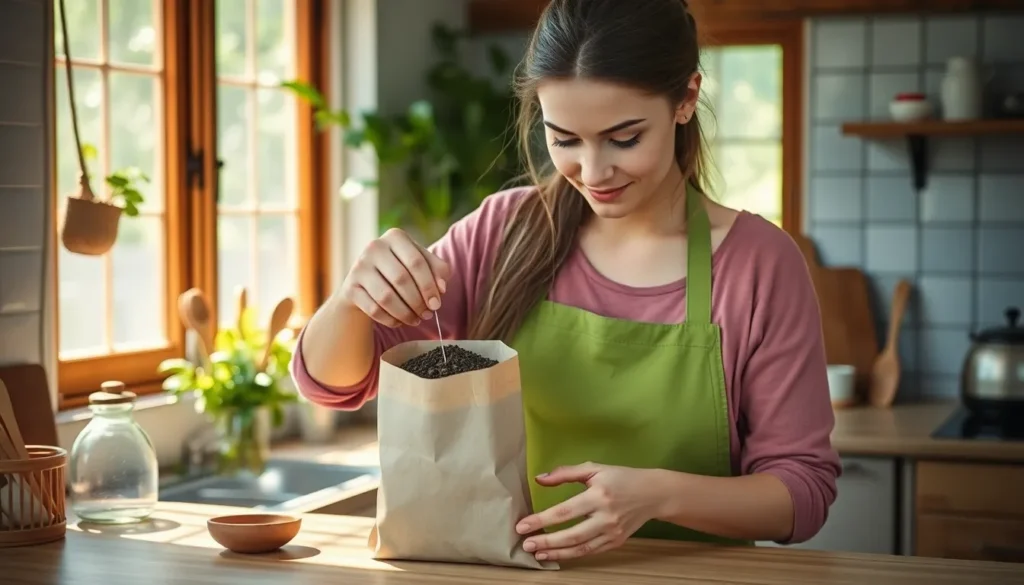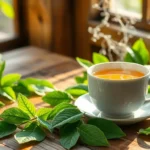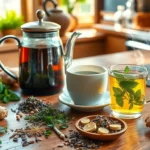Every sip of tea shouldn’t come with a side of microplastics. Yet millions of us unknowingly brew plastic particles into our daily cup when we use conventional tea bags. Recent studies reveal that a single plastic tea bag can release over 10 billion microplastic particles into your hot water – that’s concerning news for tea lovers everywhere.
We’re living through a plastic pollution crisis and our beloved tea ritual has become an unexpected contributor. Traditional tea bags often contain polypropylene plastic seals and synthetic materials that don’t just harm the environment – they’re potentially impacting our health with every steaming cup we enjoy.
The good news? Plastic-free tea bags offer a simple solution that transforms your tea time into an eco-friendly ritual. We’ll explore how these sustainable alternatives work why they’re better for both you and the planet and which brands are leading the charge toward cleaner brewing.
Understanding the Plastic Problem in Traditional Tea Bags
We’ve discovered that our morning tea ritual might be serving us more than we bargained for. The convenience of modern tea bags comes with hidden dangers that most consumers remain unaware of.
Hidden Microplastics in Your Daily Cup
Microplastic contamination reaches staggering levels in conventional tea bags, with research revealing that a single plastic tea bag releases approximately 11.6 billion microplastic particles and 3.1 billion nanoplastic particles into a single cup of hot water.
Synthetic materials commonly found in traditional tea bags include polypropylene, nylon, and polyethylene terephthalate (PET). These materials break down when exposed to hot water temperatures typically used for brewing tea.
Heat activation accelerates the release of plastic particles, as temperatures above 95°C cause synthetic tea bag materials to degrade rapidly. We’re essentially creating a microplastic infusion every time we steep our tea.
Health implications remain under investigation, but studies suggest that consuming microplastics may lead to digestive irritation and potential long-term cellular damage. The particles are small enough to cross biological barriers and accumulate in human tissues.
Environmental Impact of Conventional Tea Packaging
Ocean pollution increases dramatically through improper disposal of plastic tea bags, with billions of used tea bags ending up in waterways annually. These synthetic materials take hundreds of years to decompose fully.
Wildlife consumption of tea bag debris poses serious threats to marine animals and birds, who mistake colorful plastic fragments for food sources. The plastic accumulates in their digestive systems and can prove fatal.
Landfill accumulation grows exponentially as most tea bags contain non-biodegradable components that persist in waste management systems. Even compostable facilities struggle to process synthetic tea bag materials effectively.
Carbon footprint expands through the petroleum-based production of plastic tea bags, requiring important energy resources and contributing to greenhouse gas emissions throughout the manufacturing process.
Identifying Plastic-Free Tea Bag Materials
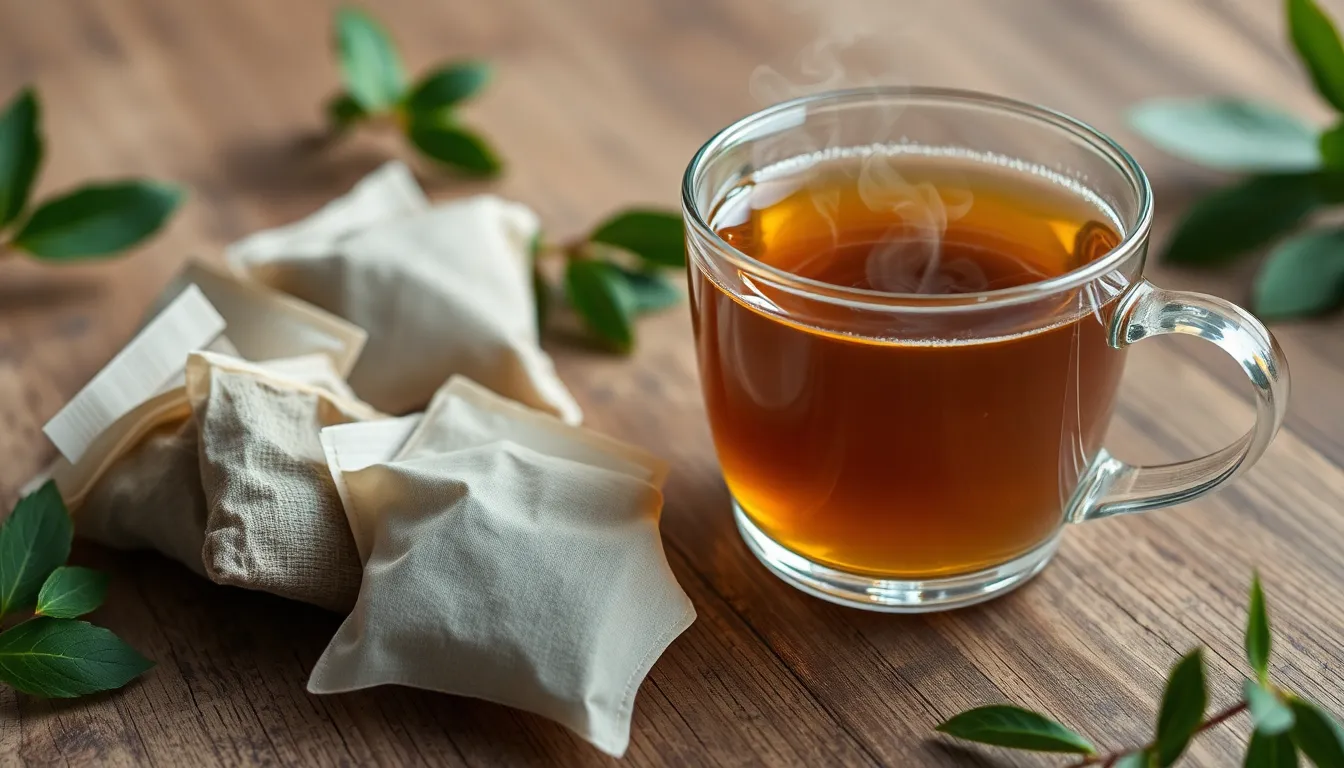
Finding truly plastic-free tea bags requires understanding the materials used in their construction. We’ve researched the most common alternatives to help you make informed choices about your tea brewing habits.
Paper-Based Tea Bag Options
Paper tea bags aren’t automatically plastic-free, even though their natural appearance. Traditional paper bags often contain fossil fuel-based plastic fibers that manufacturers use for heat sealing purposes.
Unbleached paper options provide the safest choice for plastic-free brewing. These bags rely on mechanical sealing methods rather than synthetic polymers to stay closed. Bleach-free paper varieties also eliminate the need for plastic-based sealants.
Heat sealing methods that avoid synthetic materials are becoming more common among specialty tea brands. We recommend checking product labels specifically for “plastic-free” or “no synthetic materials” statements when selecting paper tea bags.
Organic Cotton and Muslin Alternatives
Cotton tea bags offer a completely natural brewing experience without synthetic materials. These reusable options use natural fibers throughout their construction, eliminating the need for plastic sealants entirely.
Muslin alternatives provide similar benefits with their fine weave that allows optimal tea extraction. Both materials are typically compostable after use, making them environmentally friendly choices for conscious consumers.
Reusable cotton bags can be washed and used multiple times, reducing waste significantly compared to single-use options. We find these alternatives particularly valuable for loose leaf tea enthusiasts who want maximum flavor extraction.
Biodegradable Plant-Based Materials
Plant-based materials offer innovative answers for completely plastic-free tea packaging. Abaca banana fiber provides excellent strength and heat resistance while remaining fully biodegradable after use.
| Material Type | Plastic-Free? | Compostable? | Example Use |
|---|---|---|---|
| Standard paper (with PP) | No | No | Traditional brands |
| Unbleached paper | Yes | Yes | Specialty brands |
| Organic cotton/muslin | Yes | Yes | Reusable bags |
| Abaca/cellulose | Mostly | Yes | Lyons (minimal plastic) |
| Cornstarch-based PLA | Yes | Yes | Madama Flavour, Taylors |
Cornstarch-based polymers like PLA (polylactic acid) create fully biodegradable tea bags from fermented plant sugars. Madama Flavour uses Soilon, a cornstarch-derived PLA, for their pyramid tea bags that break down completely in composting conditions.
Cellulose fibers from various plant sources provide another excellent option for plastic-free brewing. Some brands like Lyons use these materials with minimal fossil fuel-derived thermoplastic fibers (less than 5%) for durability, though this technically isn’t completely plastic-free.
PLA materials made from corn or sugarcane fermentation offer the closest alternative to traditional plastic performance. These plant-based plastics decompose under proper composting conditions while providing the strength needed for effective tea brewing.
Top Plastic Free Tea Bag Brands to Try

We’ve identified several outstanding brands that have committed to eliminating plastic from their tea bags while maintaining exceptional quality. These companies use innovative materials like abaca leaf fibers, organic cotton, and plant-based cellulose to create completely compostable packaging options.
Premium Organic Tea Companies
Traditional Medicinals leads the premium segment with tea bags crafted from abaca leaf fibers and wood pulp, ensuring 100% plastic-free construction with non-GMO verification. Their commitment to both environmental sustainability and health makes them a top choice for conscious consumers.
Pukka Herbs creates fully compostable tea bags using a sophisticated blend of natural abaca and plant cellulose fibers, complete with organic cotton strings. We appreciate their attention to every detail, from the bag material to the string attachment.
Numi Teas combines organic certification with fair-trade practices while offering completely plastic-free tea bags. Their dedication to ethical sourcing extends to their packaging choices, making them a responsible premium option.
The Republic of Tea uses unbleached paper construction that’s entirely free of glue and chemicals. This approach eliminates synthetic materials while preserving the natural flavor profile of their premium tea blends.
Affordable Eco-Friendly Options
Sainsbury’s makes sustainable tea accessible through their plant-based bioplastic (PLA) tea bags that are industrially compostable. This mainstream retailer proves that eco-friendly options don’t have to break the budget.
Tetley offers select varieties featuring plant-based bioplastics, bringing plastic-free brewing to grocery store shelves nationwide. Their widespread availability makes sustainable tea choices convenient for everyday consumers.
Lipton provides certain tea bag varieties made from manila hemp and cellulose fibers that are both plastic-free and compostable. This familiar brand’s commitment to sustainability helps make the transition easier for traditional tea drinkers.
Stash delivers a variety of plastic-free tea options at competitive prices. Their diverse selection ensures that budget-conscious consumers can find plastic-free alternatives across different tea types and flavors.
Specialty Herbal and Wellness Brands
Yogi Tea specializes in herbal wellness blends while maintaining plastic-free packaging standards. Their focus on both physical and environmental health aligns perfectly with their sustainable packaging choices.
Republic of Tea extends their plastic-free commitment to their extensive herbal and wellness tea collection. We find their range particularly impressive, covering everything from digestive support to stress relief formulations in eco-friendly packaging.
Making Your Own Plastic Free Tea Bags at Home
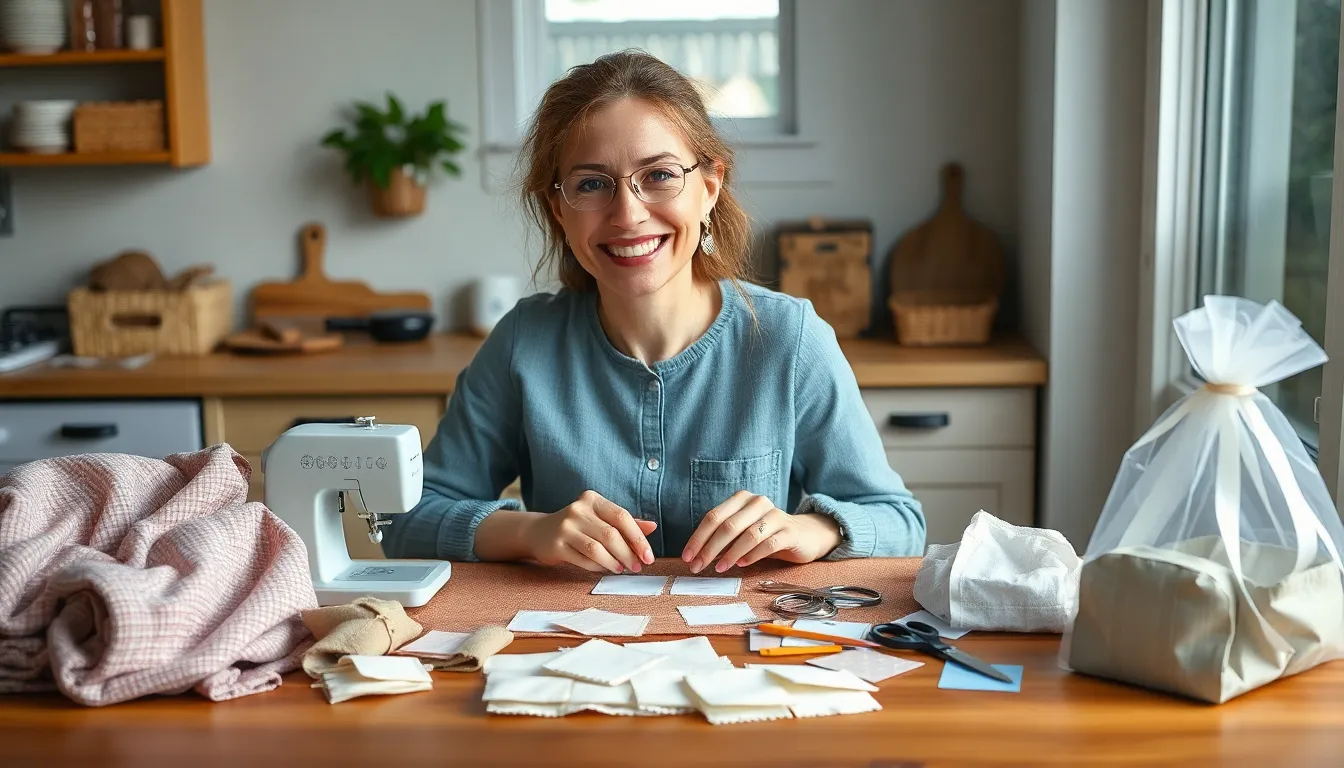
Creating your own plastic free tea bags gives you complete control over materials and costs. We’ll show you how to create sustainable tea bags using simple household items.
DIY Materials and Supplies Needed
Recycled fabric serves as the primary material for our homemade tea bags. Cotton fabric works best because it’s durable and won’t break down in hot water. We recommend using old cotton t-shirts, pillowcases, or bed sheets that you’d otherwise discard.
Scissors help you cut precise fabric squares for consistent bag sizes. Sharp fabric scissors create clean edges that prevent fraying during the sewing process.
Needle and thread secure your tea bag construction. Cotton thread matches well with cotton fabric and won’t introduce synthetic materials into your brewing process.
Small pieces of string or twine create the essential steeping loop. Natural cotton string or hemp twine works perfectly for this purpose and remains completely biodegradable.
Step-by-Step Creation Process
Cut fabric squares measuring approximately 2 inches by 2 inches from your recycled cotton material. These dimensions provide enough space for tea leaves to expand while steeping properly.
Fold each square in half to create a rectangular shape. This folding technique ensures your tea bag has proper depth for loose leaf tea.
Sew around three sides of the folded fabric, leaving one side completely open for filling. Use small, tight stitches to prevent tea leaves from escaping during steeping.
Create a small loop at the top corner by folding a small piece of fabric and sewing it securely. This loop serves as the attachment point for your string.
Fill the bag with your favorite loose leaf tea, leaving about 25% empty space for expansion. Overfilling prevents proper water circulation and reduces steeping effectiveness.
Sew the open side shut using the same tight stitch pattern. Double-check that all seams are secure before your first use.
Attach the string by tying it through the loop you created earlier. We recommend cutting strings to about 6 inches for easy handling.
Cost-Effective Homemade Answers
Using recycled fabric eliminates the need to purchase new materials and reduces household waste. This approach costs virtually nothing while providing an eco-friendly alternative to commercial tea bags.
Bulk tea purchases become more economical when paired with homemade tea bags. We can buy loose leaf tea in larger quantities and create individual servings as needed.
Reusable applications make these DIY tea bags even more cost-effective. After steeping, we can empty, rinse, and refill the same bag multiple times before replacement becomes necessary.
Time investment remains minimal once you’ve mastered the basic technique. Most people can create a week’s worth of tea bags in under 30 minutes.
Loose Leaf Tea as the Ultimate Plastic Free Alternative
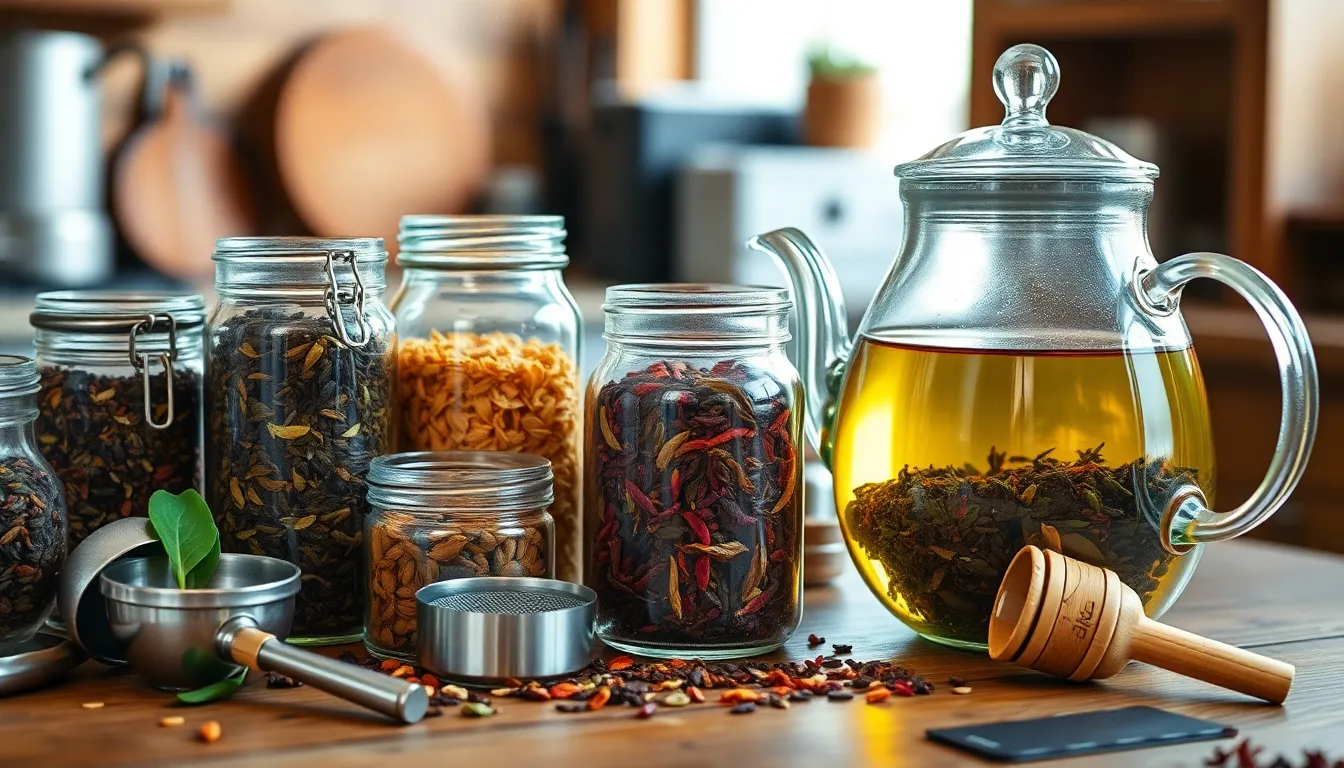
Loose leaf tea eliminates plastic contamination entirely since it doesn’t require any packaging materials that could contain synthetic polymers. We’re discovering that this traditional brewing method offers the most comprehensive solution to the microplastic problem while delivering superior taste and sustainability benefits.
Benefits of Switching to Loose Leaf
Environmental impact becomes dramatically positive when we choose loose leaf tea over conventional bagged options. Zero packaging waste means no contribution to the billions of tea bags polluting our oceans and landfills annually. Manufacturing processes avoid petroleum-based materials entirely, reducing our carbon footprint with every cup we brew.
Quality and taste reach new heights with loose leaf varieties since the leaves have complete freedom to unfurl and release their full flavor profile. Whole leaf grades contain higher concentrations of essential oils and aromatic compounds compared to the dust and fannings typically found in tea bags. We’re able to control steeping time and water temperature more precisely for optimal extraction.
Cost effectiveness becomes apparent over time as bulk loose leaf purchases offer significantly better value than individually packaged tea bags. Premium loose leaf teas often cost less per serving than conventional bagged alternatives when calculated by weight. Storage longevity extends the economic benefits since properly stored loose leaf tea maintains quality for extended periods.
Essential Brewing Equipment and Accessories
Tea infusers serve as the primary tool for loose leaf brewing, with stainless steel mesh varieties offering durability and easy cleaning. Fine mesh construction prevents tea particles from escaping while allowing water to circulate freely around the leaves. Multiple sizes accommodate different cup and teapot volumes for versatile brewing options.
Teapots with built-in strainers provide the most convenient brewing experience for loose leaf tea enthusiasts. Glass teapots allow us to observe the brewing process and appreciate the visual beauty of unfurling leaves. Ceramic options retain heat effectively while adding aesthetic appeal to our tea service.
Tea scoops ensure consistent measurements for optimal flavor extraction from loose leaf varieties. Bamboo scoops offer sustainable material choices while stainless steel versions provide precise portioning. Standard measurements typically require one teaspoon per cup plus one additional for the pot.
Storage and Freshness Tips
Airtight containers preserve loose leaf tea quality by preventing exposure to moisture, oxygen, and external odors that degrade flavor compounds. Glass jars with tight-fitting lids offer visibility while maintaining freshness, and stainless steel tins provide complete light protection. We recommend transferring tea from original packaging to these storage answers immediately after opening.
Light avoidance protects delicate tea leaves from UV degradation that breaks down essential oils and aromatic compounds. Dark cupboards or opaque containers shield our tea investments from harmful light exposure that causes flavor deterioration. Direct sunlight can damage tea quality within days of exposure.
Optimal usage timelines maintain peak flavor quality when we consume loose leaf tea within one year of opening the package. Green teas typically maintain freshness for 6-12 months while black teas can last up to two years when stored properly. Dating our containers helps track freshness and ensures we enjoy tea at its peak quality.
Health Benefits of Choosing Plastic Free Tea Bags
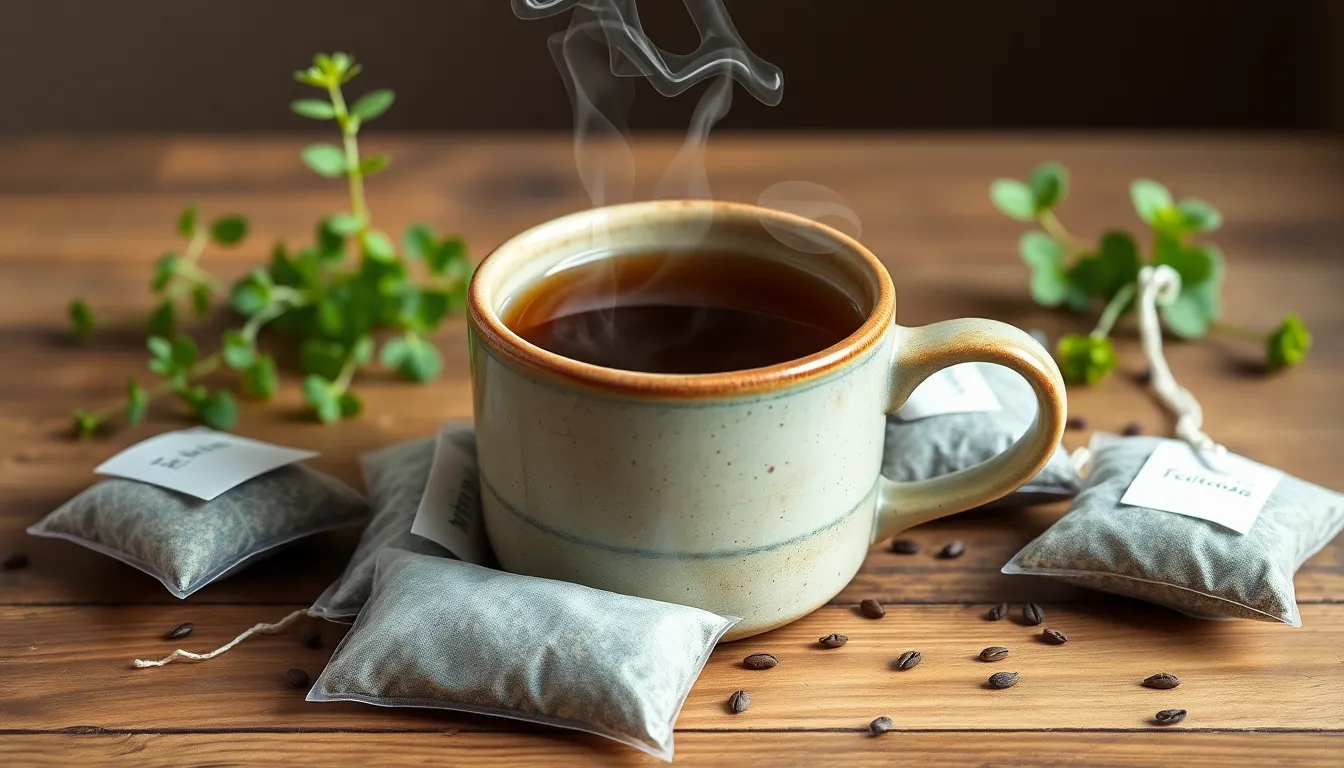
Making the switch to plastic free tea bags delivers important health advantages that go far beyond simply enjoying your favorite brew. We’ve discovered compelling evidence that these natural alternatives protect our bodies from harmful contaminants while improving our overall tea drinking experience.
Avoiding Chemical Leaching and Toxins
Plastic free tea bags eliminate exposure to dangerous microplastics and synthetic chemicals that conventional bags release into hot water. Studies reveal that traditional tea bags containing polypropylene, paper cellulose, or nylon mesh can release billions of microplastics and nanoplastics into a single cup when steeped at high temperatures. These microscopic particles have been found to be absorbed by human intestinal cells, with particles detected inside cell nuclei within 24 hours of exposure.
Biodegradable materials like hemp, linen, and organic cotton provide a safer brewing experience by avoiding harmful chemical releases entirely. Research documents important levels of microplastics and phthalates in tea from conventional bags, which are completely avoided when using plastic free options. We’re protecting ourselves from toxins known to disrupt endocrine function and accumulate in body tissues by choosing natural alternatives.
Enhanced Flavor and Aroma Quality
Plastic free tea bags often contain higher quality loose leaf tea compared to the dust and fannings typically used in conventional tea bags. The less processed leaves retain more natural oils, resulting in a richer, more robust flavor and enhanced aroma profile. Natural materials allow tea leaves to fully expand and release their essential compounds without interference from synthetic barriers.
The absence of plastic materials ensures a purer taste experience free from leaching compounds that can alter your tea’s flavor. We notice cleaner, more authentic taste notes when brewing with plastic free bags because there’s no chemical interference masking the natural characteristics of the tea. Premium leaf quality combined with natural packaging materials creates an optimal brewing environment for maximum flavor extraction.
Improved Digestive and Overall Wellness
Choosing plastic free tea bags supports better digestive health by eliminating microplastic contamination that can interfere with gastrointestinal function. Studies suggest that microplastics ingested from conventional tea bags may interact with the digestive tract, potentially leading to tissue infiltration and systemic circulation throughout the body. We’re minimizing these health risks by selecting natural alternatives that won’t introduce foreign particles into our system.
Compostable plastic free tea bags also contribute to our overall wellness by reducing environmental toxin exposure while supporting sustainable practices. The elimination of synthetic materials from our daily tea ritual helps maintain cleaner internal systems and reduces the burden on our body’s natural detoxification processes. We’re investing in long term health benefits by choosing tea bags made from biodegradable materials that align with our body’s natural processes rather than working against them.
Environmental Advantages of Plastic Free Tea Consumption
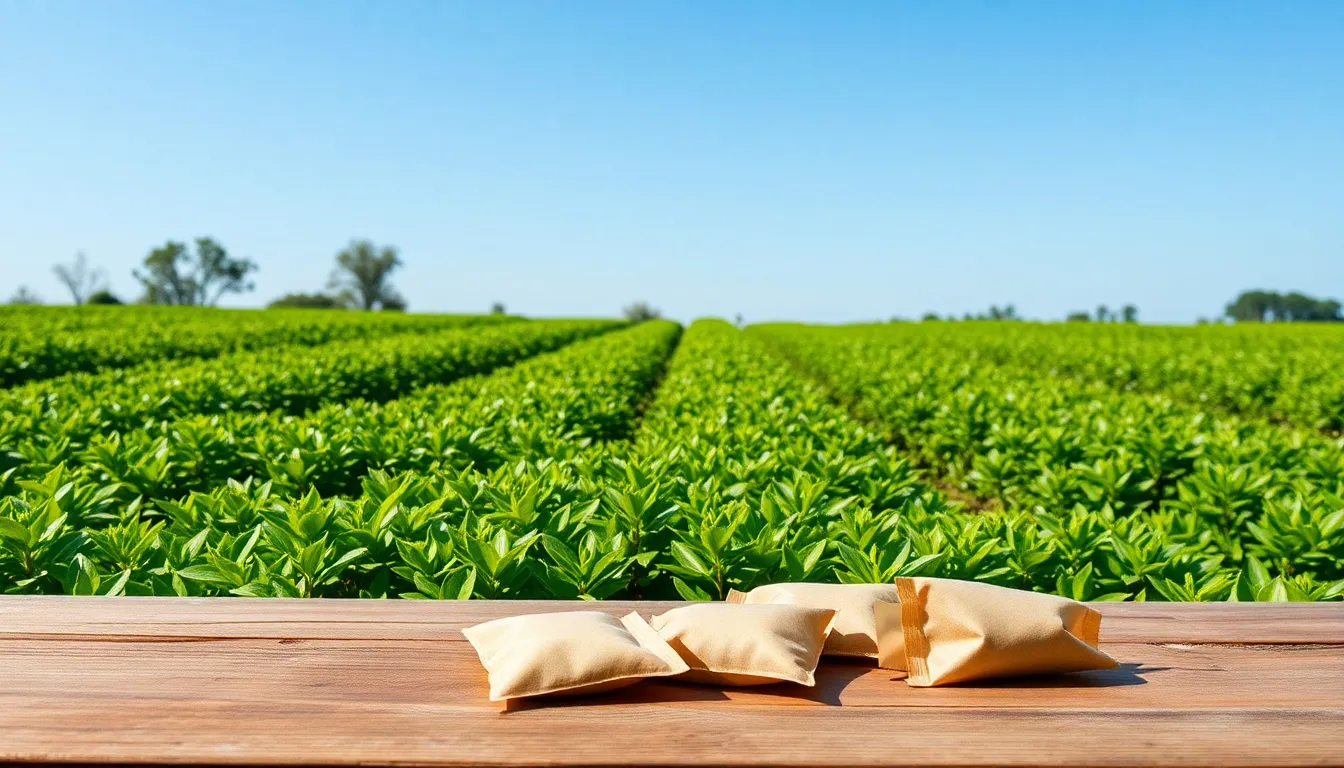
Making the switch to plastic free tea bags creates important positive environmental changes that extend far beyond our daily cup. We’re contributing to a healthier planet while enjoying our favorite beverages without compromise.
Reducing Ocean Pollution and Waste
Microplastic elimination represents the most immediate environmental benefit of choosing plastic free tea bags. Traditional tea bags release billions of microplastic particles into our tea, with these particles eventually making their way into waterways and oceans. Plastic free alternatives using biodegradable materials like Soilon or plant based fibers completely eliminate this source of contamination.
Landfill reduction occurs naturally when we choose compostable tea bags over conventional plastic versions. Standard tea bags contain synthetic materials that persist in landfills for decades without decomposing. Eco friendly options break down completely in composting environments, leaving no trace behind.
Wildlife protection improves dramatically when fewer plastic tea bags enter marine ecosystems. Ocean creatures often mistake plastic debris for food, leading to internal injuries and death. Biodegradable tea bags dissolve harmlessly in water, posing no threat to marine life.
Supporting Sustainable Agriculture Practices
Ethical sourcing practices flourish when tea companies commit to plastic free packaging. Many brands producing biodegradable tea bags also prioritize sustainable farming methods, fair trade practices, and organic cultivation techniques. These companies eliminate staples and synthetic glue from their production processes.
Renewable material usage drives innovation in sustainable packaging answers. Plant based fibers, corn starch materials, and other renewable resources replace petroleum based plastics in tea bag manufacturing. Agricultural waste products often serve as raw materials for these eco friendly alternatives.
Circular economy support strengthens when we choose brands that design their entire supply chain around sustainability principles. These companies create closed loop systems where packaging materials return to the earth safely after use.
Lower Carbon Footprint Impact
Biodegradable material production generates significantly less carbon emissions compared to traditional plastic manufacturing. Materials derived from corn starch or plant fibers require less energy intensive processing than petroleum based synthetics. Renewable sources like these reduce dependency on fossil fuel extraction.
Composting benefits multiply the environmental advantages of plastic free tea bags. Home composting systems can process these bags alongside organic waste, creating nutrient rich soil amendments. Commercial composting facilities handle biodegradable tea bags efficiently without contaminating finished compost products.
Transportation efficiency improves when lightweight biodegradable materials replace heavier plastic components. Shipping costs and fuel consumption decrease when tea companies adopt sustainable packaging answers. Local sourcing of plant based materials further reduces transportation related emissions.
Where to Buy Plastic Free Tea Bags
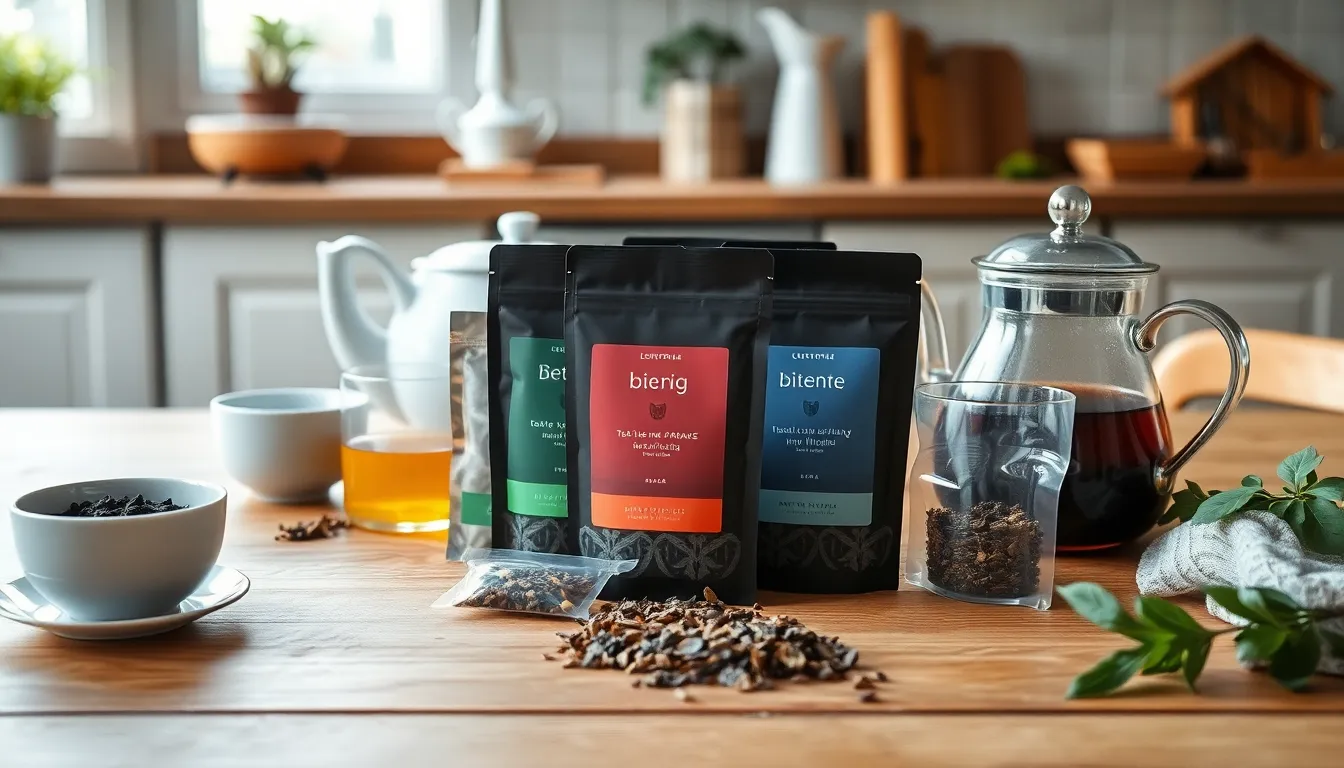
We’ve found that accessing plastic free tea bags is easier than ever before, with multiple purchasing options available both online and in physical stores.
Online Retailers and Specialty Stores
Major e-commerce platforms offer extensive selections of plastic free tea bag brands. Amazon serves customers across the USA, Canada, and UK with brands like Lyons and Madama Flavour readily available for quick delivery. Specialty tea retailers provide even more comprehensive options, with Stash Tea offering over 250 tea blends in completely plastic free packaging.
Direct to consumer websites give us access to premium brands committed to sustainable packaging. Traditional Medicinals, Pukka, Clipper, Bromley, Teapigs, and Barry’s Tea all sell their plastic free options through their official websites. Online specialty stores often provide detailed information about materials and sourcing, helping us make informed choices about our tea purchases.
Local Health Food and Organic Markets
Local health food stores frequently stock plastic free and microplastic free tea bag brands in their beverage sections. Organic markets prioritize sustainable products, making them excellent sources for discovering new eco friendly tea options.
Major supermarket chains are increasingly offering plastic free alternatives as consumer demand grows. Sainsbury’s in the UK has transitioned to plant based tea bags, while similar commitments are spreading to US retailers nationwide. Natural food cooperatives often carry lesser known brands that specialize in completely biodegradable packaging materials.
Subscription Services and Bulk Options
Tea subscription services highlight sustainable packaging as a key selling point, delivering curated selections of plastic free options monthly. Bulk tea retailers provide both online and in store access to loose leaf alternatives that eliminate packaging waste entirely.
Wholesale suppliers offer cost effective answers for households wanting to stock up on plastic free tea bags. Online bulk retailers frequently provide important discounts when purchasing larger quantities, making sustainable choices more affordable for regular tea drinkers.
Making the Transition to Plastic Free Tea Habits
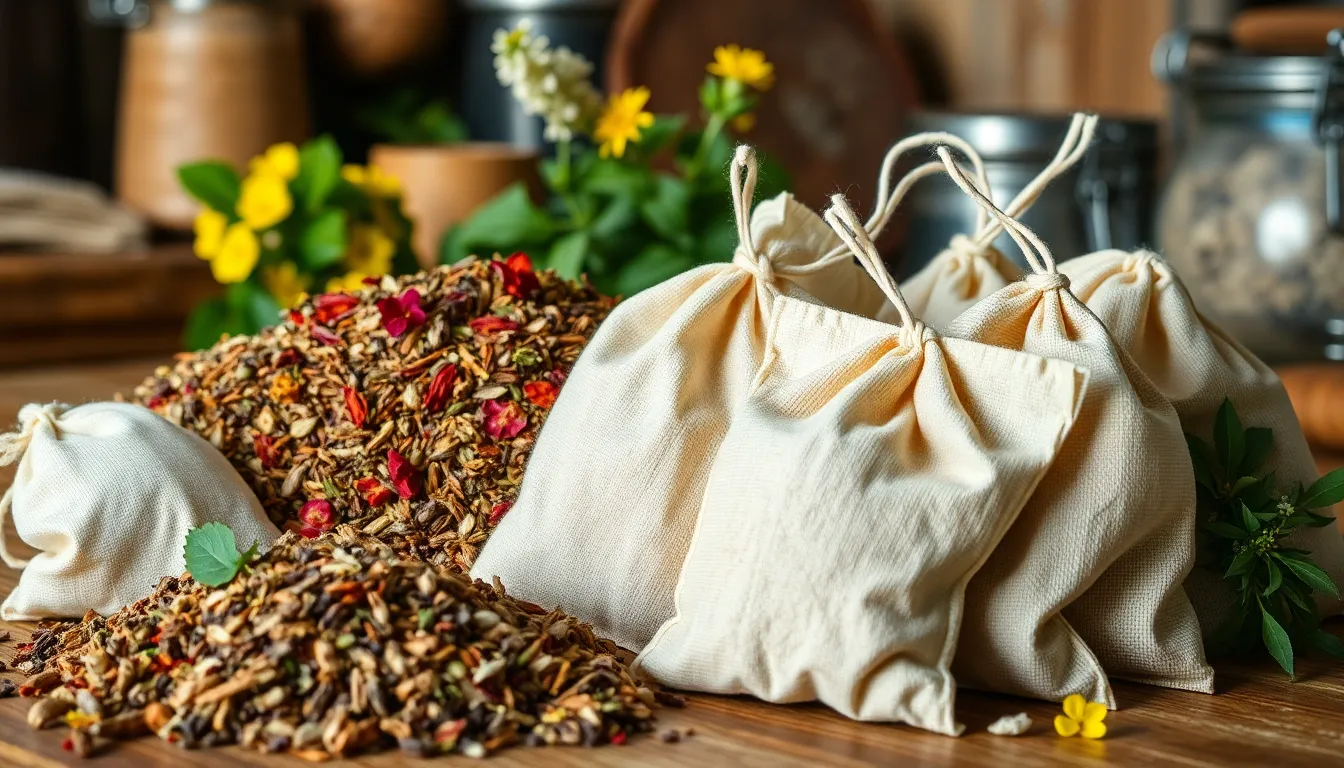
Transitioning to plastic free tea habits doesn’t have to happen overnight, and we’ve found that gradual changes often lead to more sustainable long term results. Building these new habits becomes easier when we approach the switch strategically and with budget friendly options that work for our lifestyle.
Gradual Switching Strategies
Starting with loose leaf tea eliminates the need for tea bags altogether, reducing plastic waste effectively. This approach gives us complete control over what goes into our cup while avoiding any potential contamination from synthetic materials. We can begin by replacing just one daily tea session with loose leaf options.
Choosing compostable tea bags made from biodegradable materials like cotton, abaca, or cornstarch based PLA provides a gentler transition. These materials break down completely in home composting systems while delivering the familiar convenience of traditional tea bags. We’ll notice these options feel different but perform just as well for steeping.
Opting for pyramid bags often means accessing materials like Soilon, a PLA derived biodegradable material that avoids staples and glue. These innovative designs allow tea leaves more room to expand while maintaining their eco friendly credentials. We can identify these by their distinctive triangular shape and natural appearance.
Replacing one type of tea at a time helps us adjust gradually to new textures and brewing methods. Starting with herbal teas often works best since they’re naturally caffeine free and forgiving to brew. We recommend switching our evening tea first, then morning options, and finally any specialty blends.
Budget Friendly Transition Tips
Buying loose leaf tea or plastic free tea bags in bulk reduces the per serving cost significantly. Many retailers offer discounts for larger quantities, and we’ll find that premium loose leaf options become more affordable when purchased this way. Storage in airtight containers keeps these bulk purchases fresh for months.
Using reusable cloth bags or making our own from natural fibers like cotton saves money over time. These DIY options cost just pennies to create and can be used hundreds of times before replacement. We can repurpose old cotton t shirts or linens for this project.
Looking for discounts and sales on sustainable products makes them more accessible to budget conscious consumers. Many companies offer introductory pricing on eco friendly lines, and we’ve noticed seasonal sales often feature these items. Signing up for brand newsletters alerts us to special promotions.
Shopping at local health food stores during clearance events often yields excellent deals on plastic free tea options. These smaller retailers frequently need to move inventory quickly, creating opportunities for savvy shoppers. We can ask store managers about upcoming sales or bulk ordering possibilities.
Building Sustainable Tea Rituals
Educating ourselves about different types of sustainable tea bags and their environmental benefits creates informed purchasing decisions. Understanding materials like abaca fibers, organic cotton, and biodegradable PLA helps us choose options that align with our values. We can research brands’ sustainability commitments before making purchases.
Involving family and friends in adopting plastic free tea habits multiplies our positive impact while creating accountability. Sharing information about microplastic contamination and environmental benefits often motivates others to join our efforts. We’ve found that gifting plastic free tea samples introduces others to these alternatives naturally.
Supporting sustainable brands that prioritize biodegradable packaging promotes a greener tea culture throughout the industry. These companies invest in research and development for better materials, and our purchases signal market demand for eco friendly options. We can follow these brands on social media to stay informed about new product launches.
Creating dedicated storage areas for our plastic free tea collection helps establish new routines and prevents mixing with conventional options. Designating exact containers or shelves reinforces our commitment to these alternatives. We recommend labeling storage containers to track which varieties we enjoy most.
Conclusion
Making the switch to plastic-free tea bags isn’t just a trend—it’s a meaningful step toward better health and environmental responsibility. We’ve explored how simple changes like choosing biodegradable materials or embracing loose leaf tea can eliminate billions of microplastic particles from our daily routine.
The good news is that plastic-free options are more accessible than ever. Whether you’re shopping online, visiting local health stores, or making your own reusable bags at home, there’s a solution that fits every lifestyle and budget.
By choosing plastic-free tea bags, we’re not only protecting ourselves from harmful contaminants but also supporting sustainable agriculture and reducing ocean pollution. Every cup becomes an opportunity to make a positive impact on our planet while enjoying a purer, more flavorful tea experience.
Frequently Asked Questions
What are microplastics and how do tea bags release them?
Microplastics are tiny plastic particles that break down from synthetic materials in conventional tea bags. When hot water is poured over plastic tea bags made from materials like polypropylene, nylon, or PET, they release over 11.6 billion microplastic particles and 3.1 billion nanoplastic particles per bag. These particles contaminate your tea and can be absorbed by your body.
Are all paper tea bags plastic-free?
No, many paper tea bags contain plastic fibers for heat sealing. These fossil fuel-based synthetic polymers make the bags water-resistant but release microplastics when exposed to hot water. Look for unbleached paper options that use mechanical sealing methods, or choose bags specifically labeled as “plastic-free” or containing “no synthetic materials.”
What materials are used in plastic-free tea bags?
Plastic-free tea bags are made from biodegradable materials including unbleached paper, organic cotton, muslin, hemp, linen, and plant-based materials like cornstarch-based PLA and cellulose fibers. These natural materials allow tea leaves to expand fully while breaking down completely in compost, eliminating environmental contamination.
Which brands offer plastic-free tea bags?
Premium brands like Traditional Medicinals, Pukka Herbs, Numi Teas, and The Republic of Tea use innovative materials like abaca leaf fibers. Affordable options include Sainsbury’s, Tetley, and Lipton. Specialty wellness brands like Yogi Tea focus on herbal blends with sustainable packaging. Always check labels for plastic-free certification.
Can I make my own plastic-free tea bags at home?
Yes, you can create DIY tea bags using recycled cotton fabric, scissors, needle and thread, and biodegradable string. Cut fabric into squares, add loose tea, sew edges closed, and attach string. This cost-effective method gives you complete control over materials while reducing waste and saving money.
Is loose leaf tea better than plastic-free tea bags?
Loose leaf tea is the ultimate plastic-free option as it eliminates packaging contamination entirely. It offers superior taste quality since leaves can fully unfurl and release flavors without restriction. Use tea infusers, strainers, or teapots with built-in filters for optimal brewing. Store in airtight containers away from light.
What are the health benefits of plastic-free tea bags?
Plastic-free tea bags eliminate exposure to harmful microplastics and synthetic chemicals that can leach into hot water. They support better digestive health by preventing microplastic contamination that can disrupt gastrointestinal function. Natural materials also provide purer taste without chemical interference, enhancing your overall tea experience.
How do plastic-free tea bags help the environment?
Biodegradable tea bags reduce ocean pollution and microplastic contamination in waterways. They break down completely in compost, reducing landfill waste and supporting sustainable agriculture practices. Unlike synthetic versions, they don’t threaten marine wildlife and help replace petroleum-based plastics with renewable materials.
Where can I buy plastic-free tea bags?
Plastic-free tea bags are available through major e-commerce platforms like Amazon, specialty tea retailers, local health food stores, and organic markets. Many brands offer subscription services and bulk purchasing options with sustainable packaging. Check product labels and descriptions for plastic-free certification before purchasing.
How can I transition to plastic-free tea habits?
Start gradually by trying loose leaf tea or choosing one plastic-free brand to test. Buy in bulk for cost savings and use reusable cloth bags. Educate yourself about different biodegradable materials and involve family and friends in the transition. Build sustainable tea rituals by exploring various plastic-free options.

